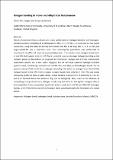Files in this item
Halogen bonding in mono- and dihydrated halobenzene
Item metadata
| dc.contributor.author | Hogan, Simon W. L. | |
| dc.contributor.author | Van Mourik, Tanja | |
| dc.date.accessioned | 2019-12-14T00:36:44Z | |
| dc.date.available | 2019-12-14T00:36:44Z | |
| dc.date.issued | 2018-12-14 | |
| dc.identifier | 256101097 | |
| dc.identifier | e1ec560f-ec33-4747-8df1-86d49900ec08 | |
| dc.identifier | 85058472683 | |
| dc.identifier | 000454098000001 | |
| dc.identifier.citation | Hogan , S W L & Van Mourik , T 2018 , ' Halogen bonding in mono- and dihydrated halobenzene ' , Journal of Computational Chemistry , vol. Early View . https://doi.org/10.1002/jcc.25733 | en |
| dc.identifier.issn | 0192-8651 | |
| dc.identifier.other | ORCID: /0000-0001-7683-3293/work/57088441 | |
| dc.identifier.uri | https://hdl.handle.net/10023/19129 | |
| dc.description | We thank EastCHEM for support via the EaStCHEM Research Computing Facility. | en |
| dc.description.abstract | Density functional theory calculations were performed on halogen-bonded and hydrogen-bonded systems consisting of a halobenzene (XPh; X = F, Cl, Br, I, At) and one or two water molecules, using the M06-2X density functional with the 6-31+G(d) (for C, H, F, Cl, Br) and aug-cc-pVDZ-PP (for I, At) basis sets. The counterpoise procedure was performed to counteract the effect of basis set superposition error. The results show halogen bonds form in the XPh-H2O system when X > Cl. There is a trend towards stronger halogen bonding as the halogen group is descended, as assessed by interaction energy and X•••Ow internuclear separation (where Ow is the water oxygen). For all XPh-H2O systems hydrogen-bonded systems exist, containing a combination of CH•••Ow and OwHw•••X hydrogen bonds. For all systems except X=At the X•••Hw hydrogen-bonding interaction is stronger than the X•••Ow halogen bond. In the XPh-(H2O)2 system halogen bonds form only for X > Br. The two water molecules prefer to form a water dimer, either located around the C-H bond (for X = Br, At, and I) or located above the benzene ring (for all halogens). Thus, even in the absence of competing strong interactions, halogen bonds may not form for the lighter halogens due to (i) competition from cooperative weak interactions such as C-H•••O and OH•••X hydrogen bonds, or (ii) if the formation of the halogen bond would preclude the formation of a water dimer. | |
| dc.format.extent | 1027311 | |
| dc.format.extent | 284811 | |
| dc.language.iso | eng | |
| dc.relation.ispartof | Journal of Computational Chemistry | en |
| dc.subject | Halogen bond | en |
| dc.subject | Hydrogen bond | en |
| dc.subject | Halobenzene | en |
| dc.subject | Density functional theory | en |
| dc.subject | M06-2X | en |
| dc.subject | QD Chemistry | en |
| dc.subject | NDAS | en |
| dc.subject.lcc | QD | en |
| dc.title | Halogen bonding in mono- and dihydrated halobenzene | en |
| dc.type | Journal article | en |
| dc.contributor.institution | University of St Andrews. Centre for Research into Equality, Diversity & Inclusion | en |
| dc.contributor.institution | University of St Andrews. EaSTCHEM | en |
| dc.contributor.institution | University of St Andrews. School of Chemistry | en |
| dc.identifier.doi | 10.1002/jcc.25733 | |
| dc.description.status | Peer reviewed | en |
| dc.date.embargoedUntil | 2019-12-14 |
This item appears in the following Collection(s)
Items in the St Andrews Research Repository are protected by copyright, with all rights reserved, unless otherwise indicated.


